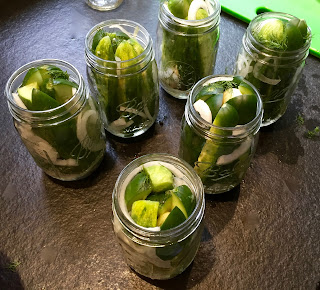Every Fall, I make a point of ‘putting up’ some farm stand produce. “Putting up” was a phrase used by our grandmothers to describe canning enough vegetables to get their families through the winter. This was long before we were able to import fresh vegetables from anywhere in the world in any season of the year, thereby stocking our grocery stores and supermarkets with the real thing all year round. But I still feel the urge to can, if not with the same urgency of our forbearers, in the same spirit. This year, I was drawn to a recipe that, as canning goes, could not be easier. You simply cut up the object to be canned, add seasoning, put the vegetable and its accompaniments into Mason jars, then pour over a brine, put the tops of the jars back on and voilà! Into your refrigerator the jars go and 24 hours later, “Pickles”! No steaming cauldrons of boiling water! And, in the case of this recipe, just a crisp, crunchy dill pickle that is both sweet and sour and far superior to anything supermarket dill pickle. It is the perfect recipe to make with children because it involves no cooking. And while you make the pickles, it’s a perfect opportunity to talk about Grandma and how she kept the family in vegetables for the winter. And all it takes a 6 1-Pint Mason Jars and 9 Kirby Cucumbers.
Kirbys are the littlest of cucumbers ranging from 3 inches to 6 inches long. You can use them in place of larger cukes but they are really ideal for pickling. The Kirby was developed by a grower named Norval E. Kirby and introduced to America in 1920. There was a whole slew of them, 9 varieties in all, with names like Black Diamond and Stay Green. By the 1930s, they’d been merged into a single dominant variety simply call Kirby. Compared to their larger cousin, they tend to be shorter, thicker, less regularly shaped, and have bumpy skin with tiny white or black-dotted spines. The cucumber itself has an ancient history of at least 3000 years and was grown in Rome in the time of Tiberius. The earliest settlers to this country discovered the ‘cowcumber’ growing in profusion. Somewhere along the line, a prejudice against eating raw fruits and vegetables came into being and for years, no one ate cowcumbers. In fact, the name ‘cowcumber’ was a reaction to that prohibition. The cowcumber was ‘fit only for consumption by cows’. How or why this prohibition was lifted is a mystery but once you’ve tasted this recipe you will be very glad it was. Here is the recipe:

















